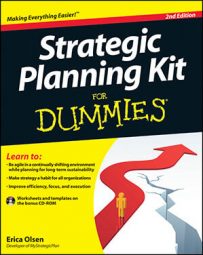So just when should you hire an outside facilitator for your strategic planning process? In an age of consultants, organizational leaders, and planners for everything under the sun, hiring a helper doesn’t come cheap. The costs to your company for strategic planning include the following:
The value of your participants’ time — more precious than ever in this time-starved world
The cost of any facility rental, AV equipment, travel, food, and lodging
The opportunity cost if, following your meeting, plans and decisions aren’t carried out or your team’s behavior doesn’t change for the better
Add up these actual and figural costs, and you can easily see how strategic planning represents a real investment. One way to maximize your investment is to engage the services of a professional facilitator. Obviously, not every meeting calls for a facilitator, but your annual retreat can probably use one.
Check out the following important instances when considering enlisting a facilitator:
When you want to participate yourself: For the most part, facilitating and participating at the same time are impossible. Some people can do both effectively, but most can’t. If you’re the boss, forget it. You can’t effectively facilitate because people still react to you as their superior.
When you need to address sensitive issues, including conflict: An outsider’s perspective can diffuse heated exchanges and channel intense emotions into constructive problem solving. Consider solving the conflict with the involved parties and bringing the rest of the team together after the problem has been resolved.
When your team is stuck: A skilled facilitator uses sensitivity to raise issues that are being avoided and to point out dysfunctional behaviors that are being denied. In this scenario, the aid of the helper gets the team moving to a new level of functioning.
When your group must deal with complex issues and a variety of viewpoints: A seasoned facilitator brings a wealth of group processes and activities to scope issues, generate options, make decisions, and build consensus.
Facilitators bring a fresh perspective to the strategic planning process. They keep the discussion on track and encourage all team members to act as equals. An outside facilitator levels the playing field between CEO and team members. In an atmosphere of informality, team members can address any issue within the organization without fear of unjust reprisal. The CEO should be involved when appropriate for his leadership, knowledge, and guidance.
For any planning sessions that you choose to run yourself, be sure to follow these best practices: have a clear agenda, require participants to come prepared, start and end on time, and manage the conversation in the room.
To run strategic planning sessions, you want to gather a set of facilitation techniques for different parts of the process. Some of my favorite facilitation exercises and methods include the following sources:
Best Practices for Facilitation: This source is the second in The Grove’s Facilitation Guide Series and is a user-friendly manual of 176 field-tested group practices. The resource proves invaluable to facilitators, managers, team leaders, and consultants looking for facilitation alternatives, such as virtual team work, graphic templates, agenda design, and group decision making. You can purchase the book at grove.com.
International Association of Facilitators (IAF): This website is the recognized source for credible and valuable professional help for practicing facilitators. On this site, you can find tons of resources related to the facilitation of best practices.
Post-It Brand Products: This website provides immediate access to sticky notes of all sizes. A strategic planning meeting without sticky notes is like an ice cream sundae without the cherry. You can do it, but it’s boring (and doesn’t taste as good — the cherry, not the sticky notes). In all seriousness, the use of sticky notes can help you gain consensus quickly, keep important ideas and topics posted on poster board–sized notes, and allow for quick brainstorming.

